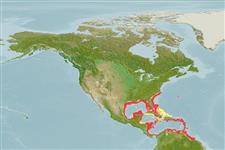Environment: milieu / climate zone / depth range / distribution range
Ökologie
seewasser demersal; tiefenbereich 24 - 133 m (Ref. 26268), usually 31 - 70 m (Ref. 26268). Tropical; 35°N - 5°N, 100°W - 55°W (Ref. 26268)
Western Atlantic: Straits of Florida in the eastern Gulf of Mexico but most common west and south of Mississippi Delta on the inner continental shelf to Guyana.
Size / Gewicht / Alter
Maturity: Lm ? range ? - ? cm
Max length : 9.0 cm TL Männchen/unbestimmt; (Ref. 7251)
Inhabits bays and shallow coastal waters (Ref. 7251); mainly on silt and soft mud substrates (Ref. 26268). Little is known of its ecology (Ref. 26268).
Life cycle and mating behavior
Geschlechtsreife | Fortpflanzung | Ablaichen | Eier | Fecundity | Larven
Munroe, T.A., 1998. Systematics and ecology of tonguefishes of the genus Symphurus (Cynoglossidae: Pleuronectiformes) from the western Atlantic Ocean. Fish. Bull. 96(1):1-182. (Ref. 26268)
IUCN Rote Liste Status (Ref. 130435: Version 2024-2)
Bedrohung für Menschen
Harmless
Nutzung durch Menschen
Tools
Zusatzinformationen
Download XML
Internet Quellen
Estimates based on models
Preferred temperature (Ref.
123201): 21.3 - 27.5, mean 25.2 °C (based on 117 cells).
Phylogenetic diversity index (Ref.
82804): PD
50 = 0.5000 [Uniqueness, from 0.5 = low to 2.0 = high].
Bayesian length-weight: a=0.01122 (0.00514 - 0.02450), b=3.04 (2.87 - 3.21), in cm total length, based on all LWR estimates for this body shape (Ref.
93245).
Trophic level (Ref.
69278): 3.2 ±0.4 se; based on size and trophs of closest relatives
Widerstandsfähigkeit (Ref.
120179): hoch, Verdopplung der Population dauert weniger als 15 Monate. (Preliminary K or Fecundity.).
Fishing Vulnerability (Ref.
59153): Low vulnerability (10 of 100).
